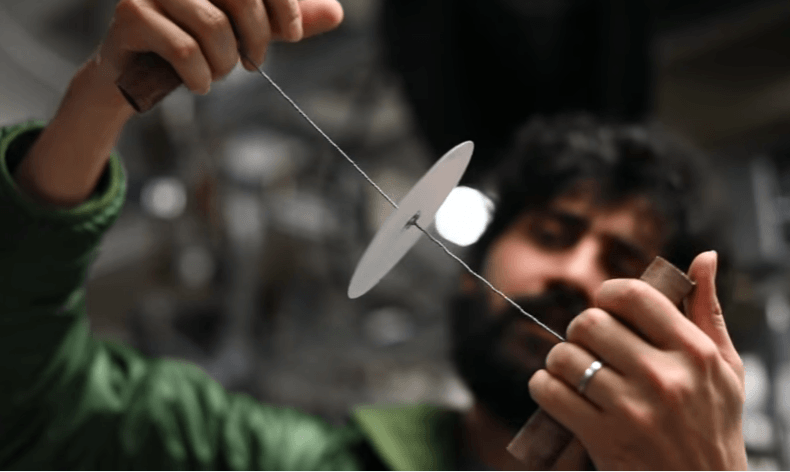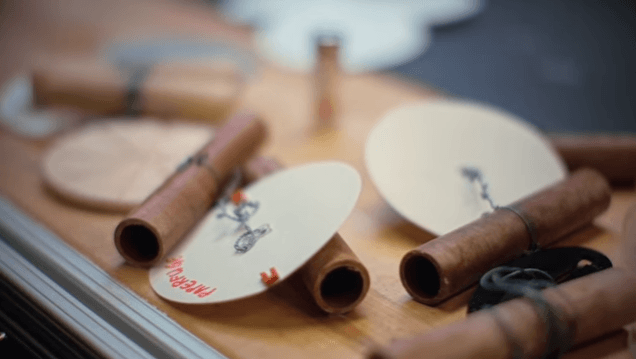One of the simplest and oldest toys known to man is the whirligig. You may have played with one yourself without knowing its name, if you’ve ever threaded a button or other disk onto a piece of string and pulled it tight to watch the disk spin. I know I have; it’s fascinating to watch how fast the disk can be made to spin, just through the simple action of loosening and tightening string.
Scientists at Stanford University have found a new use for the whirligig, a use that has the potential to have a much more significant effect than just entertainment. Manu Prakash, assistant professor of bioengineering at Stanford, was in Uganda when he realized there was a need for an inexpensive tool for malaria testing. Usually, testing for malaria and other bloodborne diseases (HIV, tuberculosis, African sleeping sickness, etc.) is conducted with a centrifuge, a device that separates blood samples into individual components. Today, they’re typically electric devices that spin samples inside a rotating drum, using centrifugal forces to separate fluids by density into layers. Heavy red blood cells will sink to the bottom of the tube, while plasma floats to the top and parasites or pathogens collect in the middle.
It’s an effective technique, but an expensive electric centrifuge is useless without electricity, which Prakash, who specializes in low-cost diagnostic tools for underserved regions, realized when he saw one of the devices being used as a doorstop in Uganda because no electricity was available to run it.
He began working with Saad Bhamla, a postdoctoral researcher in his lab, to brainstorm ways to create spinning forces with just human energy. Eventually, they began studying spinning toys invented before the industrial age, such as tops, yo-yos and whirligigs.“There are more than a billion people around the world who have no infrastructure, no roads, no electricity. I realized that if we wanted to solve a critical problem like malaria diagnosis, we needed to design a human-powered centrifuge that costs less than a cup of coffee,” said Prakash.
“One night I was playing with a button and string, and out of curiosity, I set up a high-speed camera to see how fast a button whirligig would spin,” said Bhamla. “I couldn’t believe my eyes.”
The button was spinning at 10,000 to 15,000 rpm. Excited by the discovery, Bhamla began experimenting with whirligig prototypes in the lab, finally mounting a capillary of blood onto a whirligig made from string and a paper disc. When the device was spun, the blood separated into layers just like it would in an electronic centrifuge.
Bhamla and Prakash conducted further study to determine how whirligigs actually work, recruiting three undergraduate students from Stanford and MIT to create a mathematical model. The students designed a computer simulation that included variables such as disc size, string electricity and pulling force. They also used equations from the physics of supercoiling DNA strands to understand how hand-forces act upon the coiling strings to power the disc.
“There are some beautiful mathematics hidden inside this object,” commented Prakash.
Once the computer model was validated against the performance of the prototypes, they were able to improve upon the original prototype, creating a whirligig that spins at up to 120,000 rpm.
“From a technical spec point of view, we can match centrifuges that cost from $1,000 to $5,000,” said Prakash.
They were also able to improve the safety of the device, which they dubbed a “paperfuge,” and test configurations that could be used to test for parasites in the field. Lab trials found that malaria parasites could be separated from red blood cells in only 15 minutes, and that coating the inside of the capillary with acridine orange dye made the parasites glow, allowing them to be easily seen under a microscope.
The researchers also experimented with prototyping discs from other materials, including plastic 3D printed on a Formlabs Form 2 printer. The 3D printed discs weighed 20 grams and were capable of spinning at approximately 10,000 rpm. These “3D-fuges” are lightweight but durable, and open up possibilities for mass-producing the devices at low cost.
The whirligig centrifuges aren’t the first low-cost medical tools developed by Prakash and his lab. They’re also responsible for the Foldscope, a paper microscope that costs less than a dollar and can be used to diagnose bloodborne diseases in the field; the invention is currently being used by 50,000 people around the world, and a recent Kickstarter campaign raised an incredible $393,358 (out of a $50,000 goal) to ship a million more. The lab also created a $5 chemistry set, also prototyped using 3D printers, that can be used both to teach kids about chemistry and to be used in the field to test soil and water quality, diagnose illness, and more.
Prakash hopes that these and other inexpensive tools will eventually enable health workers, field ecologists, and citizens of remote areas to carry a full laboratory in a backpack.
“Frugal science is about democratizing scientific tools to get them out to people around the world,” said Prakash.
His lab’s work was documented in an article entitled “Hand-powered ultralow-cost paper centrifuge,” which you can access here. Additional authors of the study include Bhamla, Brandon Benson, Chew Chai, Georgios Katsikis, and Aanchal Johri. Discuss in the Whirligigs forum at 3DPB.com.
[Source: Stanford University]
Subscribe to Our Email Newsletter
Stay up-to-date on all the latest news from the 3D printing industry and receive information and offers from third party vendors.
Print Services
Upload your 3D Models and get them printed quickly and efficiently.
You May Also Like
Reinventing Reindustrialization: Why NAVWAR Project Manager Spencer Koroly Invented a Made-in-America 3D Printer
It has become virtually impossible to regularly follow additive manufacturing (AM) industry news and not stumble across the term “defense industrial base” (DIB), a concept encompassing all the many diverse...
Inside The Barnes Global Advisors’ Vision for a Stronger AM Ecosystem
As additive manufacturing (AM) continues to revolutionize the industrial landscape, Pittsburgh-based consultancy The Barnes Global Advisors (TBGA) is helping shape what that future looks like. As the largest independent AM...
Ruggedized: How USMC Innovation Officer Matt Pine Navigates 3D Printing in the Military
Disclaimer: Matt Pine’s views are not the views of the Department of Defense nor the U.S. Marine Corps Throughout this decade thus far, the military’s adoption of additive manufacturing (AM)...
U.S. Congress Calls Out 3D Printing in Proposal for Commercial Reserve Manufacturing Network
Last week, the U.S. House of Representatives’ Appropriations Committee moved the FY 2026 defense bill forward to the House floor. Included in the legislation is a $131 million proposal for...





































